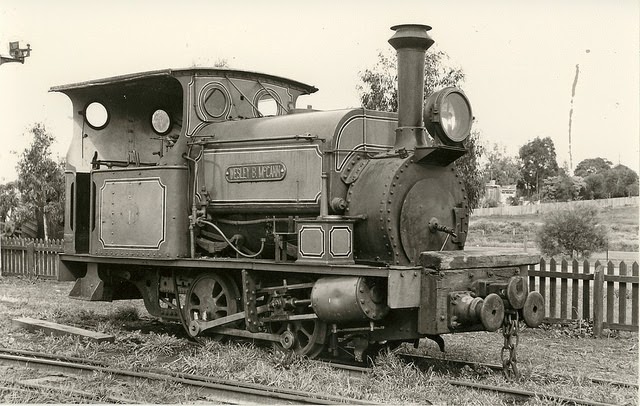The course took a gentle curve from Barwon Heads Road and lead me round towards the car park of the golf course where it disappeared into nothingness in the grass and weeds near the gateway to the car park. The route I took was grassy (albeit overgrown) and relatively firm underfoot, unlike the surrounding land which was all swampy.
 |
| The causeway through the wetlands |
 |
| Belmont Common Railway. Taken from http://www.brownfam.com.au/ROLL110/ROLL110.htm |
A quick check of Google Earth when I arrived home provided further evidence. A thin, green band can be seen curving through the wetlands from the intersection of Barwon Heads and Settlement Roads towards the road leading to the golf course.
Now it was time for a little more investigation. Where did the line run? What was its history? I knew the basics but not much more. My brother soon revealed that he remembered traveling on the train as a small child and being terrified by the steam whistle. I have no memory of it, however further research revealed quite a few details.
 |
| The Belmont Common Railway line. This image compiled for me by Chris Bridge shows Google Earth overlaid with a 1978 Melways Map and his rough estimate of the planned line. The red line shows the section of track which which was built whilst the peach shows the intended section which was never completed. The latter is based on details from the following article: http://www.sydneytramwaymuseum.com.au/members/Trolley_Wire/152%20-%20Trolley%20Wire%20-%20Jun%201974.pdf |
As part of this process, in 1968, two of the smaller engines were handed over to the Geelong Division of the Australian Railway Historical Society who opened a museum site on Belmont Common (near KMart) and in 1969 began running services on a short length of track. In its day it was the only operational main line railway museum in the country and soon extended across the common as far as Breakwater Road. By 1974 there were four engines with a variety of rolling stock offering rides for tourists on Sunday afternoons and public holidays.
 |
| Belmont Common Railway with KMart in the background. Taken from https://www.flickr.com/photos/24609616@N05/sets/72157626420795881 |
 |
| Engine #4 on the Australian Portland Cement Company line at Fyansford. Taken from: http://www.brownfam.com.au/ROLL50/ROLL50.htm |
 |
| Engine #4 on the Belmont Common Railway |
 |
| Engine #4 in 2007, restored and running on the Bellarine Railway (photo courtesy of Wikipedia) |
 |
| Engine #6 at the Fyansford Cement Works. Taken from: http://www.brownfam.com.au/ROLL50/ROLL50.htm |
 |
| Engine #6 at Belmont Common Railway. Taken from the Stephen Haby Collection, National Library of Australia |
 |
| Engine #6 pushing a tourist service on Belmont Common. Taken from http://www.brownfam.com.au/ROLL110/ROLL110.htm |
Fortuitously however, in 1976 the decision was taken to close the Geelong-Queenscliff branch line and the Belmont Common Railway took the opportunity to move operations to Queenscliff. Fundraising during 1976 and 1977 along with a government grant enabled the line to be regauged to the narrower 3ft 6in used by the Fyansford engines and in May, 1979 the first services ran, carrying tourists between Queenscliff and Laker's Siding on the reopened line which was soon extended to Drysdale Station.
Today, from its humble beginnings on the Belmont Common, the Bellarine Railway has expanded to include engines and rolling stock from across the country and in recent years, the six surviving steam engines from the Fyansford Cement works have been reunited on the Bellarine Railway.
Thanks for this detailed post. Never knew the railway existed although I lived in Newtown until end of 1972 (and uni beckoned). Helen Schofield
ReplyDeleteWesley B McCann was not the "owner" of the Cement Works. His father Peter McCann, was a founder of the original works in 1890 and involved in establishing subsequent companies after the original closed in 1902. The company was liquidated in 1905 and Peter McCann purchased the plant, with support from three original directors. The private company was restructured and registered, with one of Peter's sons, Wesley B McCann as manager and secretary. After Peter died in 1908, a new company was registered in 1911. Peter's sons Sidney and Wesley were on the board of directors and Wesley was manager. The McCann family retained significant share holdings. When the company purchased a diesel-electric locomotive in 1956, it was named Wesley B McCann. After the railway closed and steam loco No.6 was donated to the ARHS Geelong Subdivision and moved to the Belmont Common, the brass name plates from the diesel were donated and attached to the side tanks of No.6. Incidentally, the Belmont Common Railway started in 1968, not 1970.
ReplyDeleteThanks for the further comments on the above post. As far as I can ascertain, yes, the Fyansford line closed in 1968 and the two engines #4 and #6 were transferred to the Geelong arm of the Australian Railway Historical Society. In 1970 this was registered as the Geelong Steam Preservation Society. According to this reference: http://www.sydneytramwaymuseum.com.au/members/Trolley_Wire/152%20-%20Trolley%20Wire%20-%20Jun%201974.pdf
ReplyDeletelimited operation (presumably as ARHS) began in 1969 with the name change occurring in 1970 (as mentioned above). Before 1969 I gather the display was static only.
Thanks for the clarification re the McCann family. I did read the term owner in one reference, but have now updated the post to indicate that Wesley McCann was the manager.
Thanks also for the confirmation re the plates on #6. I guessed this was probably what had happened.